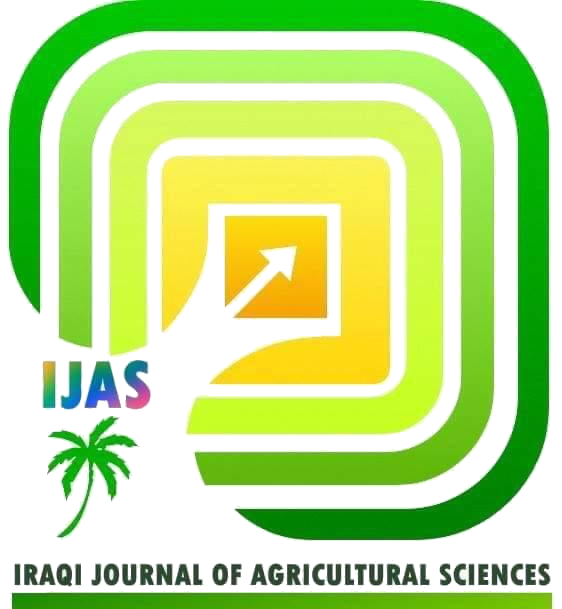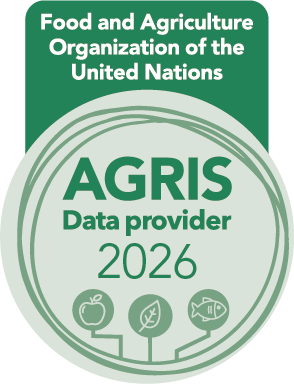FIELD AND STORAGE PERFORMANCE OF INDUSTRIAL POTATOES TREATED WITH COBALT AND SILICON
DOI:
https://doi.org/10.36103/7p19dy09Keywords:
phenols, weight losing, catalase, ascorbic acid, strategic crop, food security.Abstract
Two field and storage experiments were conducted at a Research Station affiliated with the College of Agricultural Engineering Sciences / University of Baghdad during the 2023 and 2024 season. To investigate the effect of cobalt chloride at three concentrations 0, 5, and 15 mg. L-1 (C0, C1, C2) and silica gold at four concentrations 0, 5, 10, and 15 ml.L-1 (Si0, Si1, Si2, Si3) to increase tubers production and quality and raise the storage capacity of industrial potato hybrid Hermes as factorial experiment within R.C.B.D. with three replicates. The storage experiment was conducted in the refrigerated warehouse belongs to private sector, following the same design of field experiment, the results revealed that the C1 treatment recorded the highest percentage of ascorbic acid and total phenols in tubers for both seasons while C2 treatment recorded the highest plant productivity and tuber weight in both season and lowest percentage of microbial contamination. The Si2 treatment resulted in the highest activity of catalase enzyme and the lowest weight loss percentage.
References
1. Ali, N.S. 2012. Fertilizer Technology and Uses. Ministry of Higher Education and Scientific Research. University of Baghdad. Iraq.pp:202.
2. Al-Hlfie, R.G. and, W.A Hussin. 2023. response of three beetroot cultivars to organic fertilization and foliar application. Iraq Journal of Market Research & Consumer Protection, 15 (2) : 221-234.
Doi:http://dx.doi.org/10.28936/jmracpc.15.2.2023.(21).
3. Al-Juboori, A.W., A.N. Rustum, and R. R. Mohammed, 2024. Effect of Spraying with Benzyl Adenine and Potassium on the Growth, Yield and Quality of Sweet Potato. In IOP Conference Series: Earth and Environmental Science, Vol. 1371, No. 4, p. 042044.
Doi:http://doi.10.1088/1755-1315/4/042044.
4. Aggarwal, P., R. Saini, S. Kaur, A. Dhiman, and P. Suthar. 2023. Conventional and emerging innovative processing technologies for quality processing of potato and potato-based products: A review. Food Control, 153, 109933. https://doi.org/10.1016/j.foodcont.2023.109933
5. Al-jubouri, K. D. H., I. J. Abdul Rasool, A. M.H. H. Al-Khafaji, A. J. Abdulsada, F. Y. Baktash, W. H. Hasoon, and Z. J. Al-Mousawi. 2025. Unraveling prolonged irrigation intervals and some sustainable treatments on potato starch composition, growth, and productivity in Iraq. Iraqi Journal of Agricultural Sciences, 56(1), 321-329.
https://doi.org/10.36103/s9q1w418
6. Al-Ghamry, A. M., M. A. A. El-Sherpiny, E. A. Alkharpotly, D. A. Ghazi, A. A. Helmy, M. H. Siddiqui, and E. M. Elghareeb, 2024. The synergistic effects of organic composts and microelements co-application in enhancing potato productivity in saline soils. Heliyon, 10(12).
https://doi.org/10.1016/j.heliyon.2024.e32694
7. Al-Zaidi, M. A. H. and M. A. H. Al-Jumaili 2022. Impact safe nutrientents in rasing production and chemical contentents of potato. Iraqi Journal of Agricultural Sciences ,53 (6): 1397- 1406. https://doi.org/10.36103/ijas.v53i6.1655
8. A.O.A.C. 1990. The Association of Official Analytical Chemist, Official Methods of Analysis .15th Edition, volume (1), Virginia, U.S.A.pp.771.
9. Danish, S., M. Hareem, M. Imran, N. Tahir, F. Gholizadeh, R. Datta, S.A. Alharbi, M.J. Ansari and T.A. Alahmadi. 2024. Effect of caffeic acid and cobalt sulfate on potato (Solanum tuberosum L.) plants in the presence and absence of nanoparticles-coated urea. Scientific Reports, 14(1): 20663. Doi://doi.org/10.38/541598-024-70998-2.
10. Dheyab S., N., A M.H. H. Al-Khafaji, I. J. Abdul Rasool, K. D. H. Al-jubouri, F. Y. Baktash, Z. J. Al-Mousawi, D. A. Hanoon. 2025. Reducing water consumption and improving soil, root quality of potato via environmentally sustainable treatments. Iraqi Journal of Agricultural Sciences, 55 (special): 1-9. https://doi.org/10.36103/przef771
11. He, C., J. Ma and L. Wang. 2015. A hemicellulose – bound from of silicon with potential to improve the mechanical properties and regeneration of the cell wall of rice, New Phytol, 206: 1051 – 1062.
Doi://doi.org/10.1111/nph.13282.
12. Hu, X., X. Wei, J. Ling and J. Chen. 2021. Cobalt: an Essential Micronutrient for Plant Growth? Frontiers in Plant Science, 12: 768523. Doi.10.3389/fpl.2021.768523.
13. Jaleel, C.A., K. Jayakumar, C. X. Zhao and M. Iqbal .2009. Low concentration of cobalt increase growth, biochemical constituents, mineral status and yield zea. J. Sci., Res., 1: 128 -137.doi.10.3329/jsr. vIil.1226.
14. Kazemi , M. 2012 . Effect of cobalt , silicon , acetylsalicylic acid and sucrose as novel agents to improve vase –life of argyrantamum flowers . Trends in Applied Sciences Research, 7 (7) : 579-583 . http://scialert . net /abstract /
doi . tasr.2012.579.583.
15. Majeed, B.H., R.R. Mohammed and , A.N Rustum. 2019. Effect of black seed oil and Aloe vera gel on banana fruit maturity and quality. Plant Archives , 19 (2): 4459-4462.e-ISSN : 2581-6063 (on line) , ISSN: 0972-5210.
16. Mohammed, R.R. and B.H. Majeed. 2023. Effect of moringa leaves extract, calcium, and potassium silicate on the growth, yield, and quality of strawberry fruits. Iraqi Journal of Agricultural Sciences, 54(6): 1703-1715. https://doi.org/10.36103/ijas.v54i6.1869
17. Mohammed, R.R. and B.H. Majeed. 2024. Response of strawberry growth, yield and marketable fruit quality to spraying with moringa leaf extract, calcium and potassium silicate. Iraqi Journal of Agricultural Sciences, 55(1) :440-452.
doi.org/10.36103/yf9f0c65
18. Mueller, S., H.D. Riedel and W., Stremmel. 1997. Determination of catalase activity at physiological hydrogen peroxide concentrations. Analytical Biochemistry, 245(1), pp.55-60. doi.org/10.1006/abio.1996.9939.
19. Naumann, M., M. Koch, H. Thiel, A. Gransee and E. Pawelzilk . 2020. The importance of nutrient management for potato production. Part II: Plant Nutrition and Tuber Quality. Potato Research, 63: 121-137.Hhttps : //doi.org//10.1007/s11540-019-09430-3.
20. Puppe, D., J. Busse, M. Stein, D. Kaczorek, C. Buhtz and J. Schaller. 2024. Silica Accumulation in Potato (Solanum tuberosum L.) Plants and Implications for Potato Yield Performance–Results from Field Experiments in Northeast Germany.Biology, 13(10) : 828.
https : //doi.org/10.3390/biology 13100828.
21. Saasea , K. Q. and N.K. AL-a,amry .2023. Effect of nitrogen, phosphorous and potassium levels on the productivity of industrial potatoes. Iraqi Journal of Agricultural Sciences, 54 (6) : 1726-1736. https://doi.org/10.36103/ijas.v54i6.1871
22. Vulavala, V. K., R. Elbaum, U. Yermiyahu, E. Fogelman, A. Kumar, and I. Ginzberg, 2016. Silicon fertilization of potato: expression of putative transporters and tuber skin quality. Planta, 243, 217-229. https://doi.org/10.1007/s00425-015-2401-6
23. Verma , K. K. , X. P. Song , B. Lin , D. J. Guo , M. Singh , V. D. Rajput , R. K. Singin , P. Singh , A. Sharma , M. K. Malviya , G. L. Chen and Y. R. Li. 2022 . Silicon induced drought trancein crop plants: Physiological Adaptation Strategies. Silicon, 14(5): 2443-2487. https://doi.10.1007/s12633-021-01071-x.
24. Vernon, L. S. , R. Orthofer , M. Rosa and L. Raventos .1999. Anlysis of Total Phenols and Other Oxidation Sustrates and Antioxidant by Mears of Foli-Ciocalteu Reagent, 299 : 152 – 178.
25. Wadas, W. 2022. Possibility of increasing early potato yield with foliar application of silicon. Agronomy Science, V.(2): 61 – 75. doi .org / 10.24326 /as20226.
26. Wadas, W. 2023. Nutritional value and sensory quality of new potatoes in response to silicon application. Agriculture, 13(3): 542. https : //
doi.org /10. 3390/agriculture 13030542.
27.Wang, M., R. Wang, L. A. J. Mur, J. Runa, Q. Shen and S. Guo .2021. Function of silicon in plant drought stress response. Hort. Res., 8 :254.htps://
doi.org/10.1038/s41438-021-00681-1.
28. Westermann, D. 2005. Nutrional requirments of Potatoes. American J. of Potato Res., 82: 301 – 307.
29. Wadas, W. 2021. Potato (Solanum tuberosum L.) growth in response to foliar silicon application. Agronomy, 11(12), 2423. https://doi.org/10.3390/agronomy11122423
30. Wadas, W., and Kondraciuk, T. 2025. The Role of Foliar-Applied Silicon in Improving the Growth and Productivity of Early Potatoes. Agriculture, 15(5), 556. https://doi.org/10.3390/agriculture15050556
31. Wang, L., N. Jin, Y. Xie, W. Zhu, Y. Yang, J. Wang, and J. Lyu, 2024. Improvements in the appearance and nutritional quality of tomato fruits resulting from foliar spraying with silicon. Foods, 13(2), 223. https://doi.org/10.3390/foods13020223
32. Xiao, J., Li, Y., and B. R. Jeong, 2022. Foliar silicon spray before summer cutting propagation enhances resistance to powdery mildew of daughter plants. International Journal of Molecular Sciences, 23(7), 3803. https://doi.org/10.3390/ijms23073803
33. Xue, X., T. Geng, H. Liu, W. Yang, W. Zhong, Z. Zhang, and Z. Chu, 2021. Foliar application of silicon enhances resistance against Phytophthora infestans through the ET/JA-and NPR1-dependent signaling pathways in potato. Frontiers in Plant Science, 12, 609870.
34. Youssef, E. 2023. Effect potassium silicate foliar application and water stress by using different amounts of irrigation water supply on potato plants (Solanum tuberosum L.). Egyptian Journal of Chemistry, 66(11), 317-326.
DOI: 10.21608/ejchem.2022.145158.6326
35. Zaheer, K., and M. H. Akhtar. 2016. Potato production, usage, and nutrition—a review. Critical reviews in food science and nutrition, 56(5), 711-721. https://doi.org/10.1007/BF02849120
36Zhang, L., M. Li, G. Zhang, L. Wu, D. Cai, and Z. Wu, 2018. Inhibiting sprouting and decreasing α-solanine amount of stored potatoes using hydrophobic nanosilica. ACS Sustainable Chemistry & Engineering, 6(8), 10517-10525. https://doi.org/10.1021/acssuschemeng.8b01860
Downloads
Published
Issue
Section
License
Copyright (c) 2025 IRAQI JOURNAL OF AGRICULTURAL SCIENCES

This work is licensed under a Creative Commons Attribution-NonCommercial-NoDerivatives 4.0 International License.

2.jpg)


